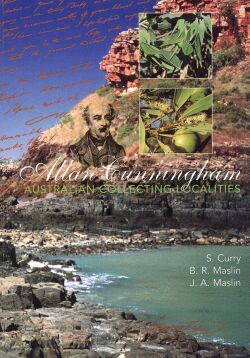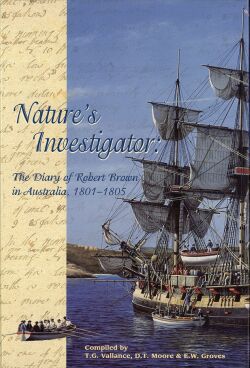|
[Front Page] [Features] [Departments] [Society Home] [Subscribe]

A Good Read
.....what's worth a look?
Reviews in this issue cover Allan Cunningham: Australian Collecting Localities by Suzanne Curry, Bruce Maslin & John Maslin, Nature’s Investigator: The Diary of Robert Brown in Australia, 1801-1805 by T.G.Vallance, D.T.Moore and E.W.Groves and Mangroves to Mountains by the Logan River Branch of SGAP (Queensland). |
 |

 
Allan Cunningham: Australian Collecting Localities
S.Curry, B.R.Maslin and J.A.Maslin
Flora of Australia Supplementary Series number 13
Published by Australian Biological Resources Study, GPO Box 787, Canberra ACT 2601, 2001
Pp vi, 90. Soft cover. ISBN 0 642 56818 9
$A27.50 including GST and surface postage
Reviewed by Alex George
This and the following publication fill much-needed gaps in the literature on early botanical explorers in Australia. Those who come after us will accept them as standard works and will have little idea how difficult it was, before they were published, to find the information they contain.
 
Allan Cunningham was a significant plant collector and explorer in Australia between 1816 and 1839. He sailed with Phillip Parker King on five voyages around the coast, explored extensively in Tasmania, New South Wales and what is now south-eastern Queensland, and visited Norfolk Island. In all he gathered more than 3000 plant collections. Although he made far better field notes than most of his contemporaries, these were not always transcribed onto the herbarium sheets bearing his specimens, some of his place names have changed, and tracing his localities has not been easy. Until now there has been no systematic compilation of his journeys, an omission here filled in a most satisfactory way. A huge amount of painstaking work has gone into gathering and arranging the information presented, and the authors and cartographer are to be commended for their persistence.
After a brief introduction summarising Cunningham's collecting activities and practices, biographical notes and a section on methodology, the text consists of:
- Part 1: Collecting localities during Phillip Parker King's Survey of coastal Australia, 1817-1822, and
- Part 2: Itinerary as Colonial Botanist in Australia'.
Each of the four voyages is described briefly, then details are given for each locality visited with the dates and co-ordinates.
Three maps show the voyages as a whole, and a further 36 maps give details of each anchorage. There is full cross-referencing between voyages. Details of where Cunningham walked at each landing were obtained from his unpublished journal, checked where necessary against King's journals and charts. It is extremely useful to have both the original and current place names. All this information is clearly set out and makes a fascinating account of exploration.
Last is 'Appendix 1. Alphabetical list of localities in Part 1'. This includes both informal and formal names. The names are set in bold italic, matching the rather odd style used for them in the text. It would have been very useful to include the place names from Part 2, an omission possibly due to a perceived restriction of space to keep the book within 96 pages overall (i.e. to avoid the need for another sheet in printing). By a more efficient use of the page (e.g. less space on p. 77, and between expedition entries in Part 2) and a smaller type size, the additional names could easily have been included.
The locality numbers on maps 2, 12, 30 and 36 are not explained in the text. They indicate the collecting sequence, except that the same number is used for a locality visited more than once.
Errors (not always typographical) occur in almost every book published, and it seems churlish to mention a few in what has been a very complex compilation. For the sake of accuracy I mention the following.
- On p. 1 the crew of the Mermaid is given as 18, on p. 67 as 19; that of the Bathurst as 32 on p. 1, 33 on p. 67. According to Hordern in King of the Australian Coast (1997), the figure was 19 on the Mermaid but the number on the Bathurst is uncertain, given as 33 by King in his log, though elsewhere he listed only 31 by name.
- Kew was not called the Royal Botanic Gardens until c. 1840; previously it was the Royal Gardens (p. 3). Joseph Banks was never formally a director there, rather an advisor to the King.
- On p. 11 in map 3, Vancouvers Well should be immediately behind the beach on the east side of the narrow entrance to Oyster Harbour, not east of Mt Martin. According to the Department of Land Management of Western Australia, the lake behind Middleton Beach is correctly Lake Seppings, not Seppings Lake (oddly, another error in this name occurs in map 1 in Nature’s Investigator, reviewed below).
- On p. 25, chapter heading, and p. 78, Tasmanian visit, it should be Diemen, not Dieman.
This book is a much-needed, essential companion for anyone requiring information on Allan Cunningham’s botanical activities in Australia. The price is extremely reasonable. I say to the authors: "Please may we now have a transcription of Cunningham’s journal!".

 
Nature's Investigator: The Diary of Robert Brown in Australia, 1801-1805
T.G.Vallance, D.T.Moore & E.W.Groves (Compilers)
Published by Australian Biological Resources Study, GPO Box 787, Canberra ACT 2601, 2001
Pp xii, 666, endpapers. Case bound. ISBN 0 642 56817 0
$A82.50 including GST and surface postage.
Reviewed by Alex George
 
So, after 200 years we have in print the Australian diaries of Robert Brown, one of the most important plant collectors to visit these shores, and later one of the 19th century's greatest botanists. This book will immediately become an essential companion for anyone researching the natural history of the Flinders voyage and Brown and co's collections during both the voyage and their explorations afterwards. Today the various versions of Brown's manuscripts are housed in seven institutions in Britain and Australia. The diary was considered by one Brownian authority to be "carelessly written . . . of little value . . ." yet these three scientists (one unfortunately now passed on) persisted and made the transcription here published, with copious annotations.
They spent 20 years poring over the manuscripts and letters, interpreting Brown's handwriting (in both English and Latin), consulting other sources and transcribing a meaningful text. In many cases they have inserted letters to complete words. Footnotes explain the interpretation of the handwriting, the people, places, plants and animals mentioned, and give cross-references to the journals of Matthew Flinders and Peter Good. Both Brown's symbols or names for places and organisms and their modern equivalents are discussed. A huge amount of detective work has gone into this compilation. Moore and Groves also located most of Brown's plant collections (more than 4000 from Australia), and have assembled a database that is accessible to researchers through the Natural History Museum, London, and the Western Australian Herbarium, Perth.
A 24-page introduction gives the background to compiling the book, the historical context of the voyage, a summary of Brown's collecting localities, his later life, the manuscript sources, the natural history collections, and the artwork of the voyage.
The diary is then presented in 27 chapters, each covering a definable part of the voyage, Brown's time in Australia and the homeward voyage. For each entry there is a heading with the day of the week, the date, the location and/or the main activity for the day. Then follows the diary entry. For many days (e.g. the stay at Sydney from June to November 1803) the information is all taken from other sources, since Brown kept no diary for those days.
The notes are themselves a mine of information. Overall we get a fascinating picture of life on a long voyage along a largely unexplored coast. Wherever possible the compilers have determined just where landings were made and the routes followed ashore. Again, I emphasise that this book will be an essential companion to anyone working with Brown's specimens. Although a botanist first, Brown and his companions also collected fauna, rock samples and data on Aborigines.
Some 41 maps, drafted by Tom Vallance and redrawn by Patrick McCarthy and Isabel Hallam, give details of the Investigator's route and anchorages, and landing sites. Some (e.g. map 22) are cluttered with unnecessary detail, especially of rivers and creeks not relevant to where they walked. The endpapers are a convenient index to the maps.
There are also 33 colour plates of photographs showing places visited, plants and animals collected, and reproductions of several Bauer paintings.
A 44-page index is comprehensive, including, very usefully, entries for names as spelt in the diary (and commonly on herbarium labels) as well as in the correct form. For other members of the expedition only a few mentions are indexed. Westall, for instance, is discussed a number of times in the notes or mentioned in the diary entries but is indexed only twice. Scientific names are not italicised.
The paper is slightly too thin, so that the print shows through the page, but results in a book that is not too thick.
The compilers and editors are to be congratulated on a wonderful achievement. It must have been a nightmare to edit, especially checking the transcription of spelling and grammatical errors and vagaries in Brown's diary. I noted a few typographical and other errors (e.g. Mallinson Is. instead of Mallison in headings on p. 379) and inconsistencies but in most cases they are not misleading, although some punctuation could be improved. In the footnotes, one matter of style that is inconsistent is the tense used when citing or reporting what Flinders or others wrote. Most of these are given in the present tense, some in the past, whereas I prefer the past tense for something that happened in the past.
In map 1, p. 95, the lake just north-east of Mt Clarence at King George Sound is Lake Seppings ('Seppines' is the spelling used in the Division of National Mapping 1: 250 000 map, SI-15). On p. 101, in the entry for 22 December 1801, note 4, the lizard described by Dampier was not an Egernia but the Bobtail or Sleepy Lizard, Tiliqua rugosa.
A key question for the reader of a review is often 'Should I buy this book?' or 'Should I recommend that our library buy it?' For an illustrated work of over 670 pages the price of $A75 is extremely reasonable, and the answer must be 'If you work or are interested in Australian botany and its history, then yes, it is well worth buying'. The volume complements Brown's Prodromus of 1810 (facsimile, 1960) and David Mabberley's biography of Brown, Jupiter Botanicus (1985). Used in conjunction with the Brown database it is an essential resource for the systematic botanist and historian.

 
Mangrove to Mountains
Logan River Branch, Society for Growing Australian Plants (Queensland)
A field guide to the Native Plants of the Logan-Albert Rivers Catchment.
Published by Copyright Publishing Co., GPO Box 2927, Brisbane 4001, 2002
$A$49.50.
Reviewed by Don Lawrie
The subtitle may imply that this is a book of narrow geographical interest; the Logan-Albert catchment is at the very south of Queensland but a majority of the plants described can be found in the entire coastal and hinterland area from Cairns in the north to, at least, well into New South Wales.
The set-up of this book departs from the usual alphabetical-by-botanical-name listing of plants. Instead five major plant habitats in the area are listed (Tidal Wetlands, Freshwater Wetlands, Eucalypt Forest, Rainforest and Mountain Tops). These cover the whole river systems from source to sea.
Imagine yourself in a mangrove area close to the coast, surrounded by vegetation ranging from tiny herbaceous plants to large trees with attached epiphytes. How do you
identify, say, that orchid-looking plant attached to a tall, rough-barked tree? Turn to the Tidal Wetlands section, outlined in blue on the page edges, and you find that some areas are dominated by Swamp Oak, Casuarina glauca. Indeed, that is the tree you are observing, as proven by the forest picture on page 12 and the close-up on page 16. Now, flick through the pictures remaining in this Tidal Wetlands section, looking for orchid-type
plants: Yep, Page 18: Pencil Orchid, Dockrillia teretifolia: "Epiphyte on paperbarks and casuarinas. Cylindrical leaves to 60cm long from wiry stems. 3cm flowers hang in loose clusters in spring." That's it alright, and while we're on that page, I see a Lily of the Valley orchid listed as growing in dense mats on trunks of Swamp Oaks; now I know what to search for, and where to find it.
Mangroves to Mountains covers 900 (yes, 900) species, ranging from giant eucalypts to tiny understorey plants. Habitat sections are sub-divided into like-coloured
plants, making comparison for identification even easier. Each plant has a clear colour photo, sometimes more than one, and some with explanatory line drawings, and a concise plant description. My copy arrived just before a Cairns Branch SGAP walk in the mangroves of Trinity Bay, and all members present were enthused by the ease with which we named a wide variety of plants by using the book. We were about 2,000 km north of the Logan-Albert area, but the book was still eminently useful.
Why all this enthusiasm for a general plant book in an Orchid Study Group Newsletter? Among the 900 plants in the book there are 56 species of native orchid, ranging over 27 genera, both terrestrials and epiphytes. Listing by habitat area, with associated plants, simplifies identification of observed orchids, or alternatively acts as an alert to the possibility of finding a specific orchid in the area.
I can unreservedly recommend this book for anyone in at least eastern New South Wales and Queensland as a reliable field guide to plants in general and orchids in particular.
Reprinted from Newsletter No. 39 of ASGAP's Orchid Study Group.

[Front Page] [Features] [Departments] [Society Home] [Subscribe]
Australian Plants online - September 2002
Association of Societies for Growing Australian Plants
|